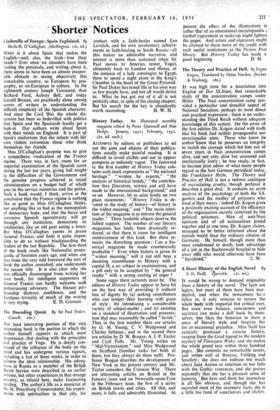History Today. An illustrated monthly magazine edited by Peter Quennell
and Alan Hodge. January, 1951; February, 195!. (2s. 6d. each.) ArrEssrrs by editors or publishers to set out the aims and objects of their publica- tions usually make painful reading. It is difficult to avoid cliches and not to appear pompous or tediously vague. The foreword to the first number of History Today con- tains such stock expressions as "the national heritage." "written by experts," "the analysis of historical trends," "the contribu- tion they [literature, science and art] have made to the international background," and so on However, let us seize firmly on two plain statements: "History Today is de- voted to the study of history—of history in the widest meaning," and "The main inten- tion of the magazine is to interest the general reader." These laudable objects deserve the fullest support. The number of our literary magazines has lately been drastically re- duced, so that there is room for intelligent reinforcement of this kind. But there re- mains the disturbing question: Can a his- torical magazine be made commercially profitable ? Even when history is given its "widest meaning," will it not still bear a daunting resemblance to History with a capital H, a set subject in examinations, and a pill only to be accepted by "the general reader" with a strong coating of sugar ?
Some sugat there certainly must be. The editors of History Today appear to have hit on the best way of providing it without loss of dignity by (a) seeking contributors who can temper their learning with grace of style ; (b) introducing a considerable variety of subject-matter ; and (c) insisting on a standard of illustration and presenta- tion that may reasonably be called " lavish." Thus in the first number there are articles by G. M. Young, C. V. Wedgwood and Charles Seltman ; and in the second there are articles by D W. Brogan, A. J. P. Taylor and Cyril Falls. Mr. Young writes on " Mid-Victorianism " and Miss Wedgwood on Strafford (familiar tasks for both of them, but they always do them well). Pro- fessor Brogan describes the development of New York in the present century and Mr. Taylor considers the Crimean War. There are interesting articles on Bristol in the January issue and on Newcastle-upon-Tyne in the February issue, the first of a series on British towns and cities. All this, and more, is fully and admirably illustrated. At present the effect of the illustrations is rather that of an educational encyclopaedia ; further experiment in make-up might lighten the pages. And artists and engravers might be allowed to share more of the credit with such useful institutions as the Picture Post library. But History Today has made a


































 Previous page
Previous page